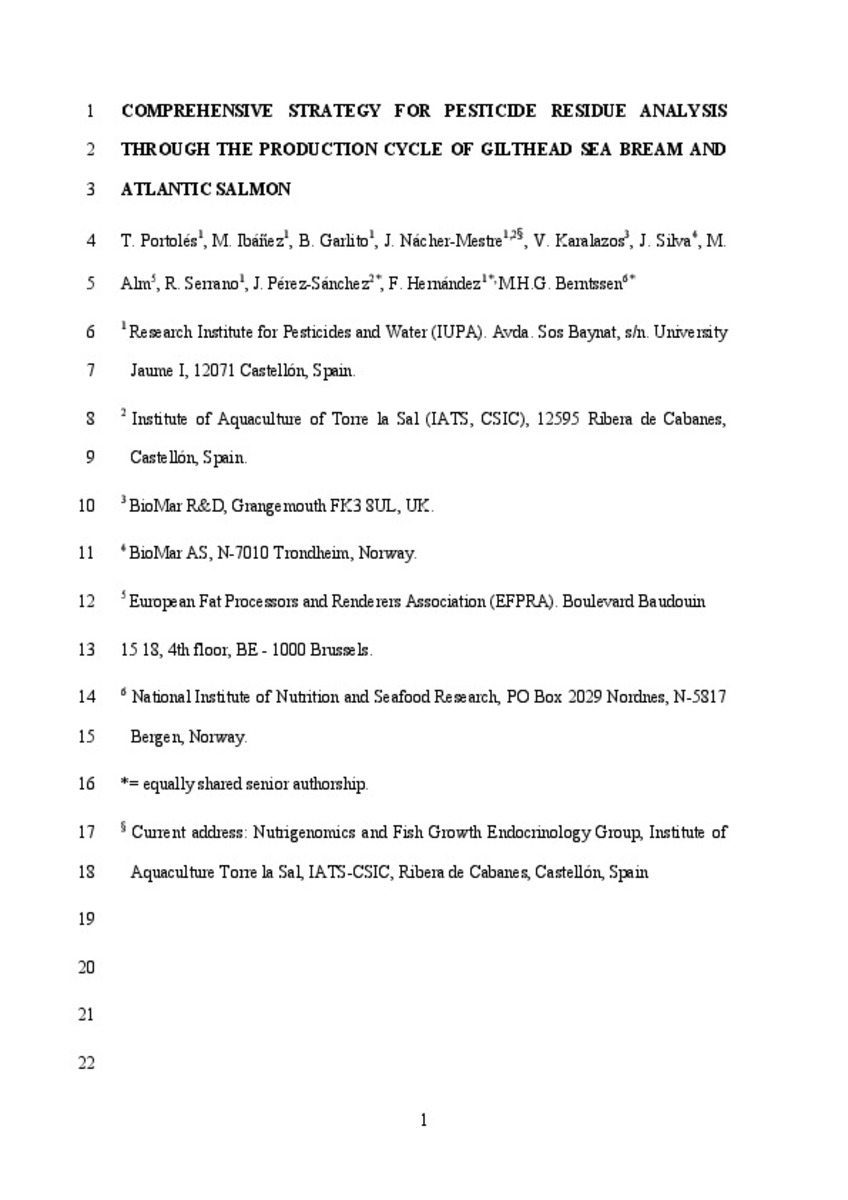Mostrar el registro sencillo del ítem
Comprehensive strategy for pesticide residue analysis through the production cycle of gilthead sea bream and Atlantic salmon
| dc.contributor.author | Portoles, Tania | |
| dc.contributor.author | Ibáñez, Maria | |
| dc.contributor.author | Garlito Molina, Borja | |
| dc.contributor.author | Nácher Mestre, Jaime | |
| dc.contributor.author | Karalazos, Vasileios | |
| dc.contributor.author | Silva, Joana | |
| dc.contributor.author | Alm, Martin | |
| dc.contributor.author | Serrano, Roque | |
| dc.contributor.author | Pérez Sánchez, Jaume | |
| dc.contributor.author | Hernandez, Felix | |
| dc.contributor.author | Berntssen, Marc H. G. | |
| dc.date.accessioned | 2017-10-31T11:03:44Z | |
| dc.date.available | 2017-10-31T11:03:44Z | |
| dc.date.issued | 2017-07 | |
| dc.identifier.citation | PORTOLÉS, T., et al. Comprehensive strategy for pesticide residue analysis through the production cycle of gilthead sea bream and Atlantic salmon. Chemosphere, 2017, vol. 179, p. 242-253. | ca_CA |
| dc.identifier.issn | 0045-6535 | |
| dc.identifier.issn | 1879-1298 | |
| dc.identifier.uri | http://hdl.handle.net/10234/169708 | |
| dc.description.abstract | Plant ingredients and processed animal proteins are alternative feedstuffs for fish feeds in aquaculture. However, their use can introduce contaminants like pesticides that are not previously associated with marine Atlantic salmon and gilthead sea bream farming. This study covers the screening of around 800 pesticides by gas chromatography (GC) and liquid chromatography (LC) coupled to high resolution time-of-flight mass spectrometry in matrices throughout the entire marine food production chain. Prior to analysis of real-world samples, the screening methodology was validated for 252 pesticides to establish the screening detection limit. This was 0.01 mg kg−1 for 113 pesticides (45%), 0.05 mg kg−1 for 73 pesticides (29%) and >0.05 mg kg−1 for 66 pesticides (26%). After that, a quantitative methodology based on GC coupled to tandem mass spectrometry with atmospheric pressure chemical ionization source (GC-APCI-MS/MS) was optimized for the pesticides found in the screening. Although several polar pesticides, of which pirimiphos methyl and chlorpyriphos-methyl were most dominant, were found in plant material and feeds based on these ingredients, none of them were observed in fillets of Atlantic salmon and gilthead sea bream fed on these feeds. | ca_CA |
| dc.description.sponsorShip | This work has been developed within the framework of the Research Unit of Marine Ecotoxicology (IATS (CSIC)-IUPA (UJI)) | |
| dc.format.extent | 12 p. | ca_CA |
| dc.format.mimetype | application/pdf | ca_CA |
| dc.language.iso | eng | ca_CA |
| dc.publisher | Elsevier | ca_CA |
| dc.relation.isPartOf | Chemosphere, 2017, vol. 179 | |
| dc.rights | © Elsevier Ltd. | ca_CA |
| dc.rights.uri | http://rightsstatements.org/vocab/InC/1.0/ | * |
| dc.subject | fish | ca_CA |
| dc.subject | feed | ca_CA |
| dc.subject | processed animal products | ca_CA |
| dc.subject | screening | ca_CA |
| dc.subject | pesticides | ca_CA |
| dc.subject | quadrupole time-of-flight | ca_CA |
| dc.title | Comprehensive strategy for pesticide residue analysis through the production cycle of gilthead sea bream and Atlantic salmon | ca_CA |
| dc.type | info:eu-repo/semantics/article | ca_CA |
| dc.identifier.doi | https://doi.org/10.1016/j.chemosphere.2017.03.099 | |
| dc.rights.accessRights | info:eu-repo/semantics/openAccess | ca_CA |
| dc.relation.publisherVersion | http://www.sciencedirect.com/science/article/pii/S004565351730471X | |
| dc.date.embargoEndDate | 2019-07 | |
| dc.contributor.funder | EU Seventh Framework Programme ARRAINA/288925; Norwegian Research Council SAFETY-PAP/227387; PROMETEOII/2014/085; PROMETEOII/2014/023; ISIC 2012/016 | ca_CA |
| dc.type.version | info:eu-repo/semantics/submittedVersion | ca_CA |
Ficheros en el ítem
Este ítem aparece en la(s) siguiente(s) colección(ones)
-
IUPA_Articles [307]







